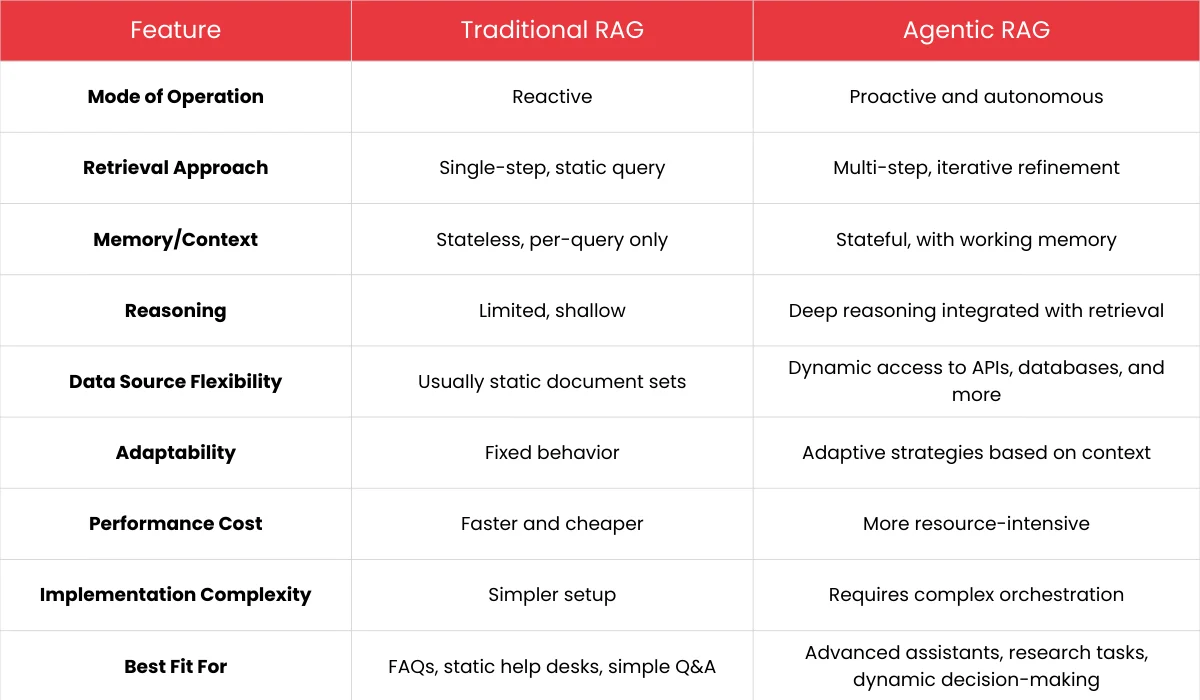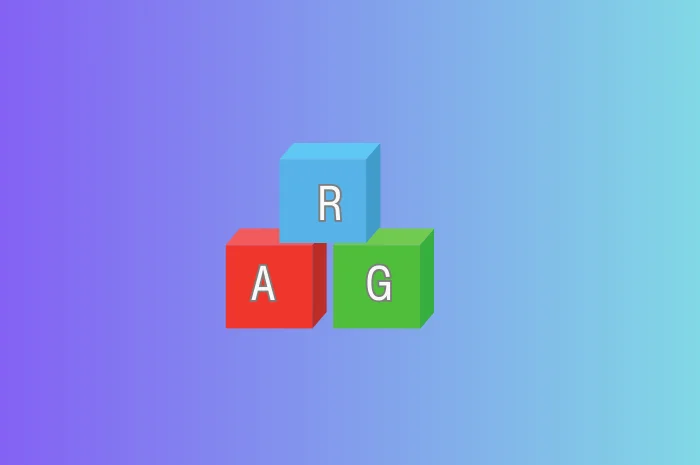As artificial intelligence continues to evolve, Retrieval-Augmented Generation (RAG) has emerged as a foundational method for enhancing language models by supplementing them with external data sources. However, Agentic RAG is extending these capabilities by combining information retrieval with autonomous reasoning and action. Grasping the distinction between these two approaches is essential for selecting the most effective AI solution for your specific use case.
This article dives deep into the Agentic RAG vs traditional RAG comparison, explaining their underlying mechanisms, key differences, and practical implications.
The Importance of Retrieval-Augmented Generation

Large Language Models (LLMs) such as GPT-4 are proficient at crafting fluent, human-like text. Yet, they come with inherent constraints:
- Stale knowledge: Their training data is frozen in time and cannot reflect recent developments.
- Hallucination risk: They may generate convincing but inaccurate or fabricated content.
- Limited access: They cannot tap into niche, private, or proprietary information sources.
- No live updates: They lack built-in mechanisms to integrate real-time data.
RAG mitigates these issues by connecting the model to external knowledge bases during query time. Instead of relying solely on the information encoded during training, RAG supplements the model’s responses by actively pulling in external content at runtime, enhancing accuracy and relevance. This results in more accurate, timely, and context-aware outputs.
Traditional RAG: The Basics

The traditional RAG method follows a straightforward two-stage process. Retrieval, where a user’s question triggers a search through an indexed knowledge base to find relevant documents. The second stage is generation, where the retrieved materials are fed into the language model, enhancing its ability to answer the query accurately.
Typical workflow of RAQ looks like this:
- A user submits a question.
- The system converts it into a query for the knowledge base.
- Top-matching documents are retrieved.
- These are passed into the model as input context.
- The model generates an answer based on both its pretrained knowledge and the retrieved content.
Benefits of Traditional RAG
- Simplicity: Easy to implement using existing components.
- Performance: Typically needs just one pass for retrieval and response generation.
- Speed: Fast inference due to minimal computational steps.
- Cost-efficiency: Lower infrastructure and compute needs.
Drawbacks of Traditional RAG
- Only responds to queries; no initiative or planning.
- If the first retrieval is lacking, the model doesn’t try again.
- Every interaction is stateless, with no cumulative learning.
- Not ideal for complex queries requiring multiple steps or sources.
- Cannot adjust its approach based on the task or evolving context.
Agentic RAG: A Step Toward Autonomous AI

Agentic RAG advances the traditional RAG model by integrating agent-like behavior, where the system not only retrieves data but also reasons, plans, and adapts. In this setup, retrieval becomes part of a larger decision-making process, allowing the AI to act more like an autonomous assistant than a reactive tool.
Core Attributes of Agentic RAG:
- Autonomy: Chooses what to retrieve and how, without waiting for explicit user prompts.
- Iterative search: Revises and refines queries over multiple cycles.
- Context awareness: Remembers past interactions and builds on them.
- Multi-source capability: Dynamically queries APIs, databases, and diverse data streams.
- Informed reasoning: Uses retrieved content strategically to guide its generation and actions.
The workflow of Agentic RAG
An Agentic RAG system begins by understanding the user’s overall goal and breaking it down into manageable, actionable sub-tasks- a process known as goal comprehension. Once the objective is clear, the system moves into strategic planning, where it identifies which data sources, tools, or APIs are best suited to address the task and formulates a plan for querying them.
It then performs smart retrieval using semantic or vector-based techniques to fetch contextually relevant information. After gathering this data, the system critically evaluates its quality and relevance, checking for inconsistencies or gaps. If the initial retrieval is incomplete or imprecise, the system enters a query refinement phase, adjusting or reissuing its search to improve the results.
With the most accurate and comprehensive data in hand, it proceeds to informed generation, crafting a response that blends external facts with its own language model knowledge. Finally, through learning and feedback, the system adapts over time, using user responses or task outcomes to refine its reasoning and retrieval strategies continuously.
Also Read: Why Retrieval-Augmented Generation (RAG) Is Key for Smarter Chatbots?
Why Agentic RAG is Game-Changing
Agentic RAG’s iterative and autonomous approach allows it to address problems that are too nuanced or dynamic for traditional RAG models:
- Layered questions: Responds to queries that need multi-faceted data synthesis.
- Dynamic inputs: Adapts to changing data environments, including live APIs.
- Advanced reasoning: Evaluates multiple possibilities to form conclusions or suggest next steps.
- Self-improvement: Recognizes when its current knowledge falls short and actively seeks better sources.
Comparative Overview: Traditional vs Agentic RAG

Contrasting Use Cases of Agentic and Traditional RAG
Scenario 1: AI in Medical Diagnosis
Traditional RAG: Receives a list of symptoms and returns relevant medical documentation or guidelines.
Agentic RAG: Proactively checks for missing context (e.g., patient history), queries electronic health records, reviews recent clinical studies, and integrates these findings into a comprehensive diagnostic suggestion.
Scenario 2: Advanced Customer Service
Traditional RAG: Searches a product manual or FAQ page to answer straightforward queries.
Agentic RAG: Tracks the entire customer journey, queries support tickets, billing history, and warranty data, and generates context-aware solutions, even taking the initiative to ask follow-up questions or escalate issues.
Also Read: LLM vs. LCM: AI Model Comparison
Challenges in Deploying Agentic RAG
While promising, Agentic RAG systems come with several hurdles:
- Retrieval precision: Iterative queries must be accurate, or errors can compound.
- System complexity: Requires tight integration between agents, retrievers, and generators.
- Ethical concerns: Risk of biased or harmful retrievals from unverified sources.
- Scalability: Resource-heavy architecture demands efficient deployment strategies.
- Data governance: Handling real-time and sensitive data necessitates strict security and privacy controls.
Final Thoughts
While both Traditional and Agentic RAG enhance LLMs by grounding their outputs in external knowledge, they serve different purposes.
Traditional RAG works best in straightforward, response-driven tasks where efficiency and ease of use are key. It’s an ideal solution for environments with predictable questions and limited data variability.
Agentic RAG, on the other hand, brings autonomy and advanced reasoning to the table, making it the better choice for dynamic, high-stakes tasks that require adaptive problem-solving, memory, and integration of diverse data types.
As we move toward a future shaped by increasingly intelligent AI agents, Agentic RAG represents a critical shift, not just in architecture, but in how AI engages with and learns from the world around it.
Frequently Asked Questions (FAQ)
1. What is Retrieval-Augmented Generation (RAG)?
RAG is an AI approach that improves language models by retrieving relevant external information like documents or database entries at the time of query, then using that data to generate more accurate and up-to-date responses.
2. What is Agentic RAG?
Agentic RAG builds on traditional RAG by adding autonomous decision-making. It not only retrieves information but also plans, iteratively refines its searches, and manages context to solve complex tasks more effectively.
3. What is the main difference between Traditional RAG and Agentic RAG?
Traditional RAG reacts to a single user query with a one-time retrieval and response, while Agentic RAG proactively plans multiple retrieval steps, reasons over the gathered information, and adapts its approach dynamically to provide richer, more precise answers.



